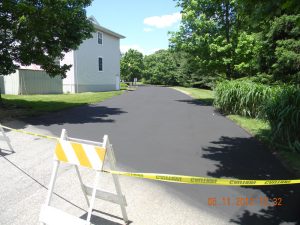Have you ever driven down the road and noticed big chunks of asphalt missing? This happens when a stretch of road needs to be replaced. This is called pavement milling or cold planing; it removes part of a paved surface, like a road or parking lot, so that new asphalt can be laid on top. Milling can be needed to level a paved surface or to repair damage to the pavement that has happened over time.
The Basics
Pavement milling is done by using a huge machine called a milling machine, or to some, a cold planer. These machines use large rotating drum to remove and grind the surface of the asphalt. There are also cutters in the drum that slice into the pavement, making it easy and clean to remove. Once the pavement has been cut by the cutters, the uprooted asphalt moves into the drum and then onto a conveyor belt that is attached to a milling machine. To prevent rising temperatures and heat produced by the machine, water is used on the drum. This also decreases the risk of elution any dust particles caused by the milling process.
Micro Milling
Pavement milling can go way beyond the basic process described above. Micro-milling uses a special rotating drum that has many more cutting teeth compared to a regular milling drum. The teeth are close together, so when the asphalt is laid, it creates a smooth surface rather than making ridges in some milled areas. Micro-milling is great to make a smooth surface. However, it can only be done at a shallow depth, unlike traditional pavement milling.
The Many Uses of Pavement Milling
The main reason for pavement milling is to recycle the road surface; asphalt can be torn up, ground down, and re-laid to make a smooth driving or parking surface. This is both cost-effective and environmentally friendly, as it does not require laying down new asphalt.
Pavement milling can also help with bumpy and uneven paved roads and damage that has occurred from car accidents or fire. Over time, the binder and aggregate used on some roads can become separated from each other. Through pavement milling, these can be mixed together and relaid, which will prevent any separation in the future.
One use of pavement milling that many do not think of is that it can actually be used to create rumble strips. They can be added to new roads or even to preexisting ones with this ingenious process.
Questions? Ask PTG Enterprises
If you still have more questions about the pavement milling process or want to know more about maintaining your paved surfaces, trust PTG Enterprises. We offer commercial concrete, masonry, asphalt installation, repair, and paving in Baltimore, Harford, Anne Arundel, Howard, and PG Counties. Give us a call today at 410-636-8777 and visit us online. Too see examples of our work, follow us on Facebook, Twitter, YouTube, LinkedIn, Google+, and Flickr.
Tags: Asphalt Maintenance, milling, My Pavement Guy, paving, PTG Enterprises


















